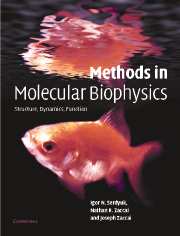Book contents
- Frontmatter
- Contents
- Foreword by D. M. Engelman
- Foreword by Pierre Joliot
- Preface
- Introduction: Molecular biophysics at the beginning of the twenty-first century: from ensemble measurements to single-molecule detection
- Part A Biological macromolecules and physical tools
- Part B Mass spectrometry
- Part C Thermodynamics
- Part D Hydrodynamics
- Chapter D1 Biological macromolecules as hydrodynamic particles
- Chapter D2 Fundamental theory
- Chapter D3 Macromolecular diffusion
- Chapter D4 Analytical ultracentrifugation
- Chapter D5 Electrophoresis
- Chapter D6 Electric birefringence
- Chapter D7 Flow birefringence
- Chapter D8 Fluorescence depolarisation
- Chapter D9 Viscosity
- Chapter D10 Dynamic light scattering
- Chapter D11 Fluorescence correlation spectroscopy
- Part E Optical spectroscopy
- Part F Optical microscopy
- Part G X-ray and neutron diffraction
- Part H Electron diffraction
- Part I Molecular dynamics
- Part J Nuclear magnetic resonance
- References
- Index of eminent scientists
- Subject Index
- References
Chapter D6 - Electric birefringence
from Part D - Hydrodynamics
Published online by Cambridge University Press: 05 November 2012
- Frontmatter
- Contents
- Foreword by D. M. Engelman
- Foreword by Pierre Joliot
- Preface
- Introduction: Molecular biophysics at the beginning of the twenty-first century: from ensemble measurements to single-molecule detection
- Part A Biological macromolecules and physical tools
- Part B Mass spectrometry
- Part C Thermodynamics
- Part D Hydrodynamics
- Chapter D1 Biological macromolecules as hydrodynamic particles
- Chapter D2 Fundamental theory
- Chapter D3 Macromolecular diffusion
- Chapter D4 Analytical ultracentrifugation
- Chapter D5 Electrophoresis
- Chapter D6 Electric birefringence
- Chapter D7 Flow birefringence
- Chapter D8 Fluorescence depolarisation
- Chapter D9 Viscosity
- Chapter D10 Dynamic light scattering
- Chapter D11 Fluorescence correlation spectroscopy
- Part E Optical spectroscopy
- Part F Optical microscopy
- Part G X-ray and neutron diffraction
- Part H Electron diffraction
- Part I Molecular dynamics
- Part J Nuclear magnetic resonance
- References
- Index of eminent scientists
- Subject Index
- References
Summary
Historical review and introduction to biological problems
1875–1880
J. Kerr first observed the transient electric birefringence effect (TEB) and established that the birefringence is proportional to the square of the field strength. Later, the law was named after him.
1880–1920
During this time high d.c. voltage generation was used in the study of TEB. It seriously hampered the application of TEB to the study of aqueous solutions because of their conductivity. In 1940–1950 a few groups (W. Kaye and R. Devaney, N. A. Tolstoy and P. P. Feofilov, C. T. O'Konski and B. H. Zimm, and H. Benoit) independently initiated the measurements of the electric birefringence of colloidal systems using a short rectangular electrical pulse. This greatly reduces the heating and polarisation effects, which are most critical in studies biological macromolecules.
1910
L. Langevin proposed the first theory for electric birefringence. In 1918 M. Born generalised the theory. It was shown that the orientation of optically anisotropic molecules may be caused by a permanent dipole momentum or its electrical anisotropy, or both. In 1931, A. Peterlin and H. A. Stuart extended the theory to suspensions of rigid particles.
1951
H. Benoit developed a theory for transient phenomena by solving the diffusion equation, which describes the rotational diffusion of axially symmetric rigid macromolecules following the establishment and disappearance of an electric field. He showed that the rotational diffusion coefficients can be obtained from the decay curve and the mechanism of electrical orientation can be elucidated from the build-up curve.
- Type
- Chapter
- Information
- Methods in Molecular BiophysicsStructure, Dynamics, Function, pp. 414 - 434Publisher: Cambridge University PressPrint publication year: 2007



